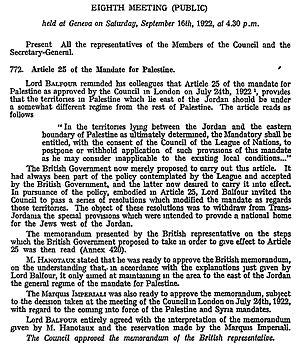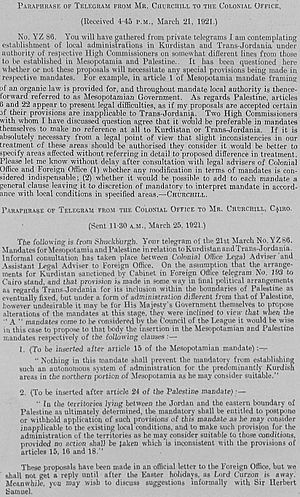Trans-Jordan memorandum facts for kids
The Transjordan memorandum was an important agreement made by the British government. It was approved by the League of Nations (an international group like today's United Nations) on September 16, 1922. This agreement was added to the British Mandate for Palestine.
The memorandum explained how Britain planned to use a special rule called Article 25 of the Mandate. This rule was created during a meeting in March 1921 called the Cairo Conference. It allowed Transjordan to be part of the Mandate, but without certain rules, especially those about Jewish people settling there.
Contents
Why This Agreement Was Made
The British government was in charge of the area known as Mandatory Palestine. The part west of the Jordan River was managed from Jerusalem. The area east of the Jordan River, called Transjordan, was first managed by a British representative named Captain Alex Kirkbride.
In November 1920, Abdullah bin al-Hussein arrived. He later became the leader, or Emir, of Transjordan. This happened after his brother, Faisal bin Hussein, was removed from Syria by the French in July 1920. At the Cairo Conference in March 1921, Abdullah was made Emir of Transjordan. It was also agreed that Jewish people would not be allowed to settle in Transjordan.
What Was Article 25?
Article 25 of the Mandate for Palestine allowed some parts of the Mandate to not apply to Transjordan. On September 16, 1922, Lord Balfour from the United Kingdom spoke to the League of Nations. He reminded them about Article 25, which they had already approved.
Lord Balfour explained that the British government now wanted to use this article, as they had always planned. He then presented the Transjordan memorandum for the League of Nations to approve.
Defining the Borders
The Transjordan memorandum was the first document to clearly draw the border between Transjordan and Mandatory Palestine. The border was described as: "all territory lying to the east of a line drawn from a point two miles west of the town of Akaba on the Gulf of that name up the centre of the Wady Araba, Dead Sea and River Jordan to its junction with the River Yarmuk: thence up the centre of that river to the Syrian frontier."
This same border had been set earlier by the High Commissioner in September. It marked the area where the Palestine Order in Council rules applied.
Rules That Did Not Apply
The memorandum listed several rules from the Mandate that would not apply to Transjordan. These included parts of the introduction and Articles 2, 4, 6, 7, 11, 13, 14, 22, and 23. Importantly, this included the rules about creating a Jewish national home.
The memorandum ended by saying: "In the application of the Mandate to Transjordan, the action which, in Palestine, is taken by the Administration of the latter country will be taken by the Administration of Transjordan under the general supervision of the Mandatory. His Majesty's Government accept full responsibility as Mandatory for Transjordan, and undertake that such provision as may be made for the administration of that territory in accordance with Article 25 of the Mandate shall be in no way inconsistent with those provisions of the Mandate which are not by this resolution declared inapplicable."
From that time on, Britain managed the area west of the Jordan River as Palestine. The area east of the Jordan River was managed as Transjordan. Even though they were technically one mandate with two territories, many official papers treated them as separate. In May 1923, Transjordan was given self-government, meaning it could manage its own affairs. Abdullah was the ruler, and Harry St. John Philby was the chief British representative.



